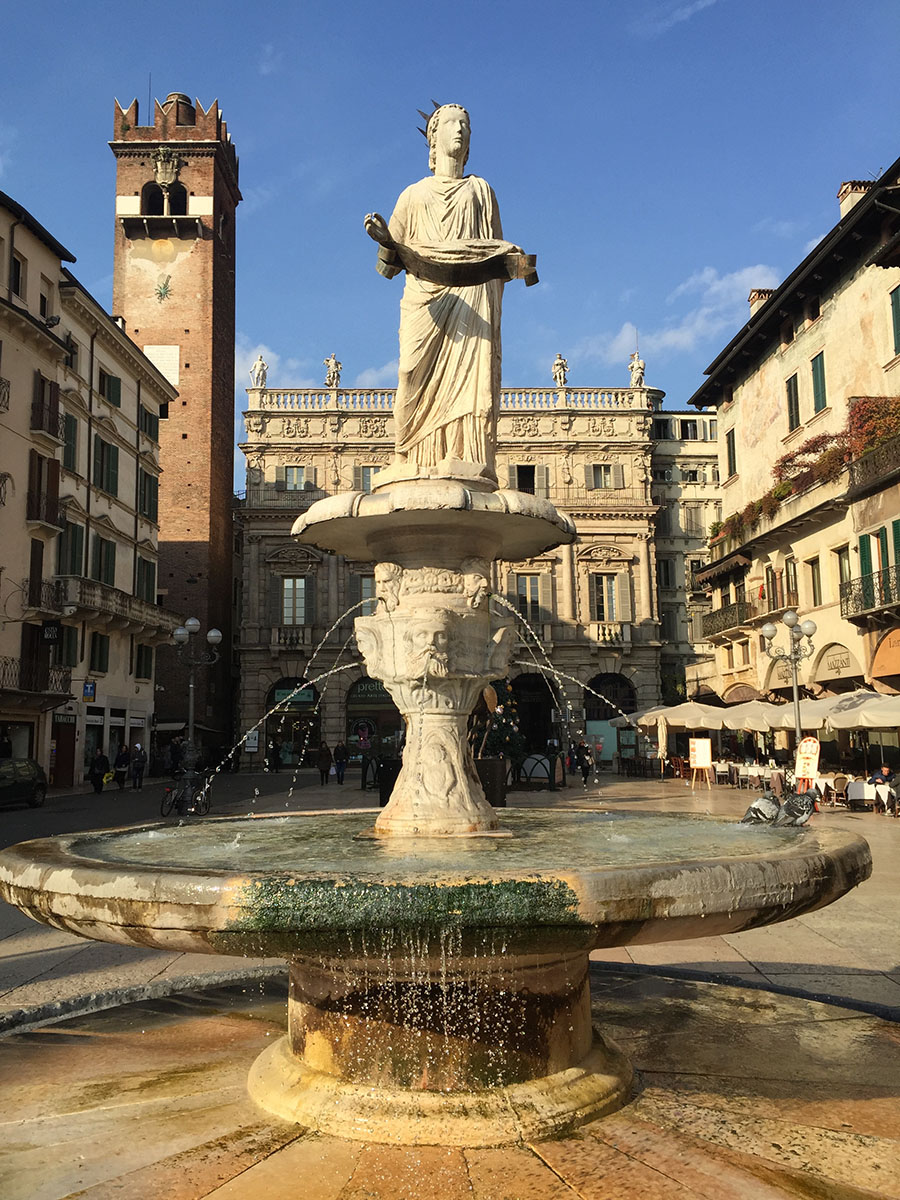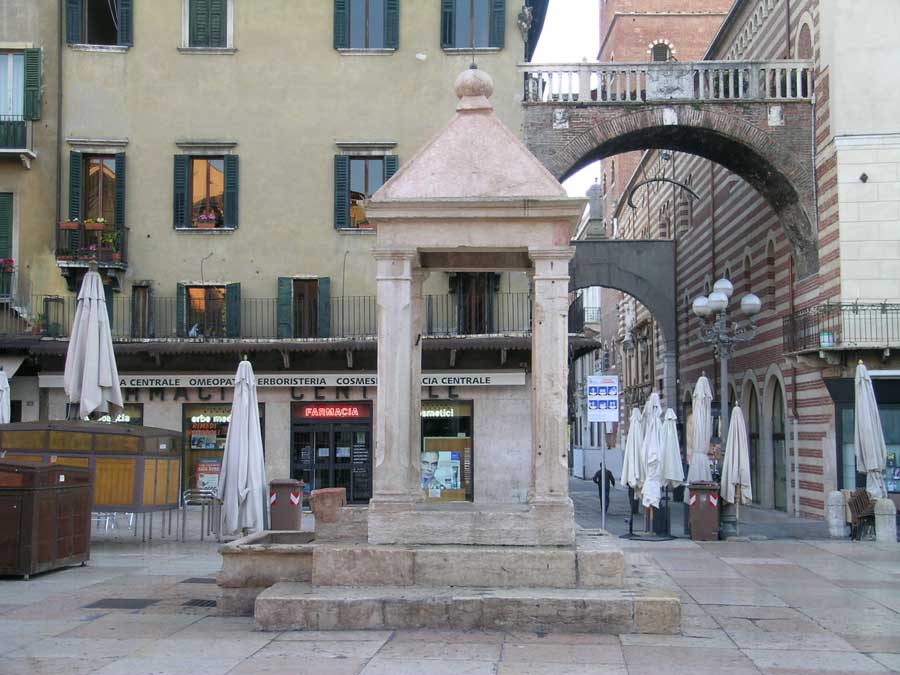Piazza Erbe, places and monuments
Palazzo Maffei

Maffei Palace was built in the licentious period of architecture and its design arrived in Verona from Rome in 1668: a branch of the Maffei family stayed in the capital for two centuries.
The building has three floors resting on five arches of a false portico: the ground floor was built this way because they took into account the needs of the market. The main floor is adorned with five large windows with alternating gables, arched and angled. Balustrades, half-columns, and grotesque masks complete the imposing parade.

The upper floor alternates three windows and two doors on a railed balcony, while under the balustrade supporting the six Olympian statues runs a decorative band of corbels, scrolls, and rich festoons.
The gods are all carved in local stone (Minerva, Neptune, Apollo, Venus, and Jupiter) except for Hercules: he was candid because he was carved from a block of Parian marble found during the excavation of the foundations.
The Maffei Family
In 1409, the Maffei family was reported to live in contrada San Sebastiano (in the area of the present palace). The family consisted of Angela Guarienti, widow of Nicolò Maffei, and her sons Marcantonio and Nicolò: the latter was married to Benedetta Fumanelli; the two had four daughters and a son, named Rolandino.
Nicolò Maffei became a regular Theatine cleric in the convent of Santa Maria della Giara and his wife and four daughters became nuns in the monastery of San Cristoforo. When Angela Guerienti died, Marcantonio Maffei and his nephew Rolandino remained. It was these two Maffei who, in 1626, wishing to rebuild their palace, appealed to the City Council to intervene against the shop owners.
Lamberti Tower

The Lamberti Tower dates back to the 12th century and the presence of several bells earned it the name 'Turris a Campaneis' (Tower of Bells). It rises in Piazza delle Erbe, towards the corner of the Costa, and its construction is said to date back to 1172. A certain mystery has always hovered around the Lamberti family, who built the tower.
Two bells were placed on it by the resolution of 28 November 1295: a small one - which was to be used in case of fires - and a larger one that (mainly) served to gather the city council and to call the citizens to arms in defence of the town. Cast several times, the two bells still retain their old names, Marangona and Rengo.

The tower rises vertically and is 84 metres high. It is composed of two stylistically distinct parts: the lower part rises to a total height of 37 metres and is built in rows of tuff and brick; the upper part, on the other hand, is built entirely of brick and dates back to the second half of the 15th century.
Gardello Tower

The Gardello Tower was erected for civic prestige in 1370 by Cansignorio: there was a bell clock on it. In 1661, a clock was also placed on the nearby Lamberti Tower. The bell of Gardello Tower was cast by Mastro Jaco in 1370, as recalled by the inscription and the plaque at the base of the tower.
It was the first bell to vibrate in Verona, thanks to the mechanical clapper of the clock, to mark the passing of the hours for citizens. With the passing of time it lost its initial purpose - to mark time for the citizens - and became the object of dispute between the Demanio and the Comune. It remained the right of the town hall, but it still lies mute.

The Gardello bell played an important role in the Scaliger era and is the symbol of one of the first moments of progress in mechanics.
Domus Mercatorum

On the left side of Piazza delle Erbe stands the Palace of the Chamber of Commerce, where the Consuls of the Markets and the Courts of Commerce have had their seat since the beginning of the 13th century. In the area where the Domus Mercatorum was erected, a wooden house was built by Realdello Delle Carceri in 1210 for the use of the Wool Guild.
In 1301, Alberto I della Scala built in the same place the present Domus Mercatorum for 'the use of the representatives of the bodies of arts! Among these, especially proud was that of the wool guild", whose main function was to judge matters of commerce.
The building was completed in 1304 and was called the Merchants' House; it took the name of Chamber of Commerce only from the early 19th century.
Madonna Verona

Madonna Verona fountain represents a symbolic personification of the city and is the oldest monument adorning the square: it is approximately two thousand years old. Originally, the statue erected in the Forum in 380 A.D. by Valerio Palladio, stood in the Campidoglio.
The lower lap is formed by four crowned heads in whose diadems are written, in Gothic letters, the names of those who took part in the events of the city according to the history or legend. These were Vero, Alboin king of the Lombards, Berengar emperor, and Verona queen.
To complete the symbol, a radiated crown was placed on the statue's head, while in its hands was placed a ribbon with the old motto of the municipality: 'This city is a dispenser of justice and a lover of praise'.

The statue, symbol of the city, embodies the splendour and wealth of Verona and expresses:
- longevity, through the body of the Roman age;
- development, as it witnesses the evolution of the city under the Scaliger Seigniory in medieval times
Capitello o Tribuna (Capital or Tribune)

In Piazza delle Erbe stands a marble canopy, raised and supported by four pillars wrongly called 'Berlina', whose name is - instead - Capitello. Inside it, the lords and the Podestà were proclaimed and installed: it contained a marble chair, which is now gone.
On the steps and the pillars are samples of the Veronese trade measurements: the pole, the pitch, the bridge, the dimensions of the roof tile and the quarel (brick), while attached to a chain is the ring that measured the thickness of the bundle of wood.
Here, the heads of the bandits were displayed for recognition, while blasphemers and other offenders were plunged into the pool.
The capital was the symbol of negotiation and the centre for the needs of the respective trade. Here sat the magistrate, who was in charge of settling and resolving any disputes that might have arisen between sellers and buyers.
Colonna Viscontea (The Visconti Column)

This column occupies the place of the ancient Berlina, which was used throughout the Venetian era for the public humiliation of condemned prisoners. The column existed during the period of the Visconti domination and may have been erected by Gian Galeazzo Visconti himself to place a sign of his authority.
The present column rests on a coarse, red marble base and is a pillar worked in spiral at the corners, bearing an aedicule, ending in a pyramid shape, and with small columns in the corners. The representations of the tribolate Gothic recesses have disappeared. Once, Saints Zeno, Peter the Martyr, Christopher, and the Virgin were carved in the recesses: when Verona came under the rule of the Serenissima, the symbols of the Visconti domination were removed.
The Virgin Mary and the Saints in bas-relief, which today can be seen in the recesses of the spire, date back to 1929 and are the work of the sculptor Di Colbertaldo.
Colonna Di San Marco O Colonna con il Leone Alato (St Mark's Column Or Column with the Winged Lion)

In Piazza delle Erbe there is St Mark's Column, made of white Veronese marble and erected by the city in 1523 to witness its devotion to Venice after the unfortunate imperial rule. The winged lion was sculpted by Pyrgoteles (pseudonym of Lascari) and was placed on the column in 1524.
A resolution of March 1524 gave it the right of asylum for debtors, which, however, lasted only a short time. The column was designed by Michele Leone, an architect from Verona, son of the stonemason Pietro da Porlezza: the capital bears the coats of arms of Doge Gritti, Podestà Marcello, and Captain Tron of Verona. In May 1797, the Lion was torn off from the column by the Veronese Jacobins; the current Lion was sculpted by Cesare Poli and was relocated on the column in 1886.

The coats of arms on the base of the column are those of the Camerlenghi, or treasurers, Giacomo Marcello, and Girolamo Capello.
Arco della Costa (Arch of the Rib)

In Piazza delle Erbe, the rib of a whale or ichthyosaur hanging under the arch connecting Palace of Reason to Domus Nova is curious. It is supposed to be one of the exotic museum pieces that at the time was used to hang in the apothecary shops.
On that street, in fact, there were at least three apothecary shops on the ground floor of the Domus Nova; moreover, the pontesello (the vernacular name of Arco della Costa) was partly owned by the apothecary at the Sirena, while the free part was used to ring the tower bell.

The whale rib actually has an often unknown historical origin. It dates back to the battle of Lepanto and was brought to the city by the citizens to celebrate Verona's contribution in the battle. The choice fell on this object, which was unknown to most but extremely symbolic: whale ribs, in fact, adorned the helms of Turkish ships.
